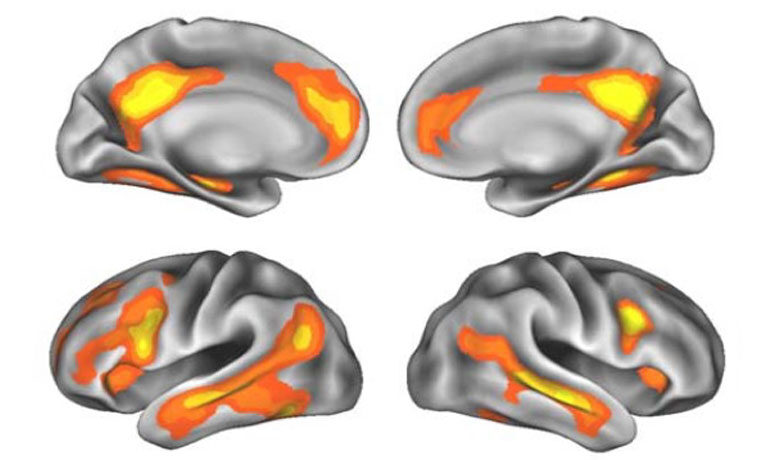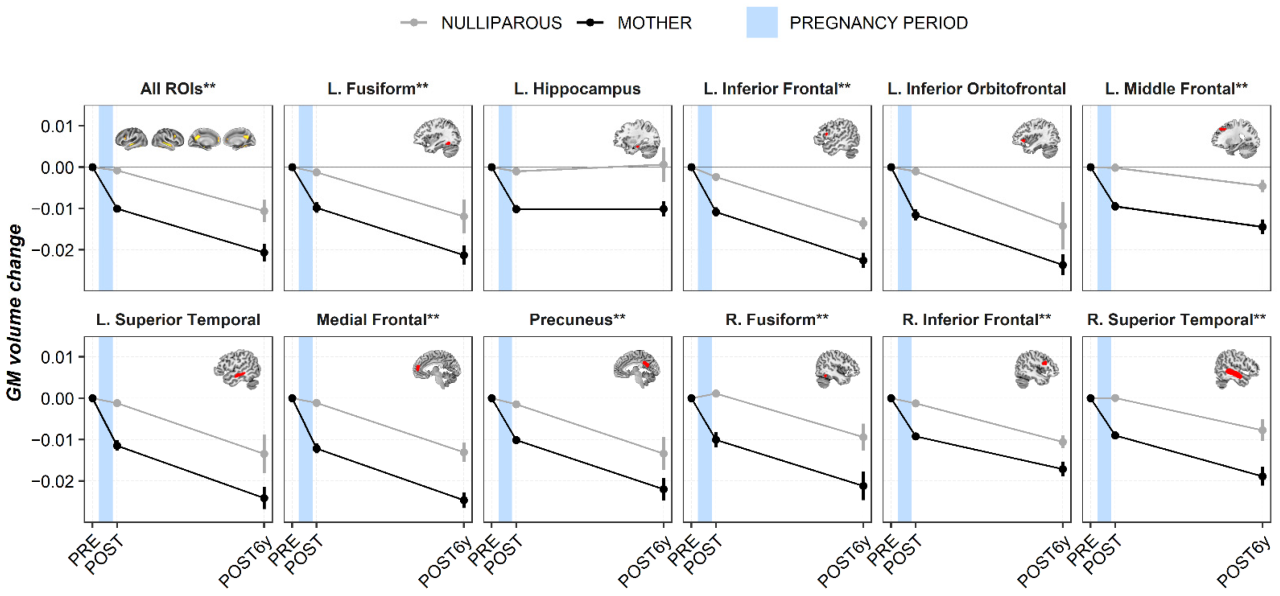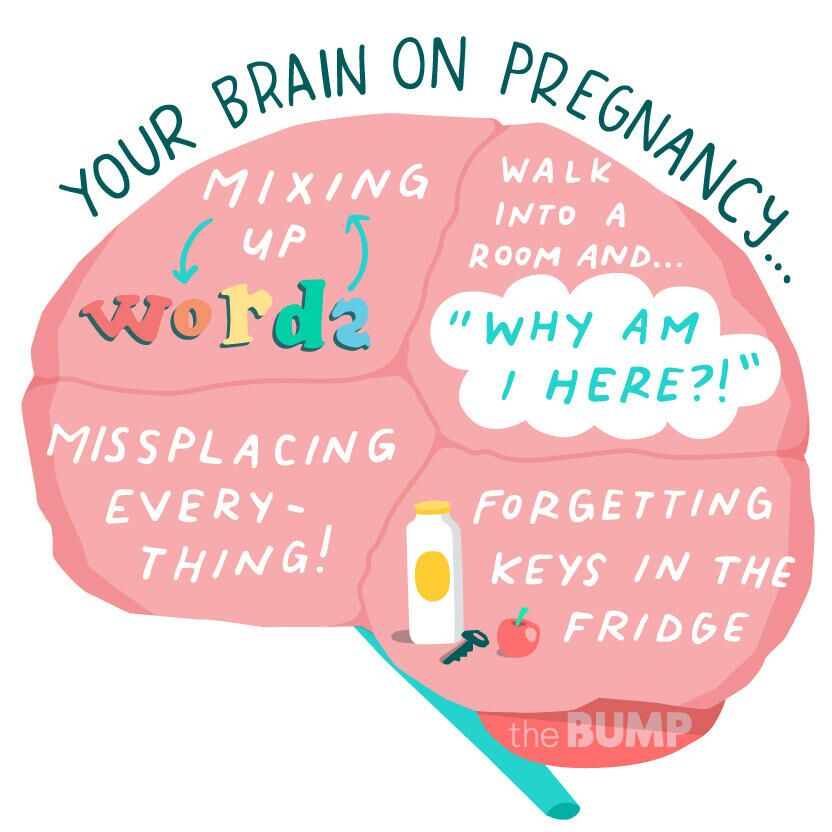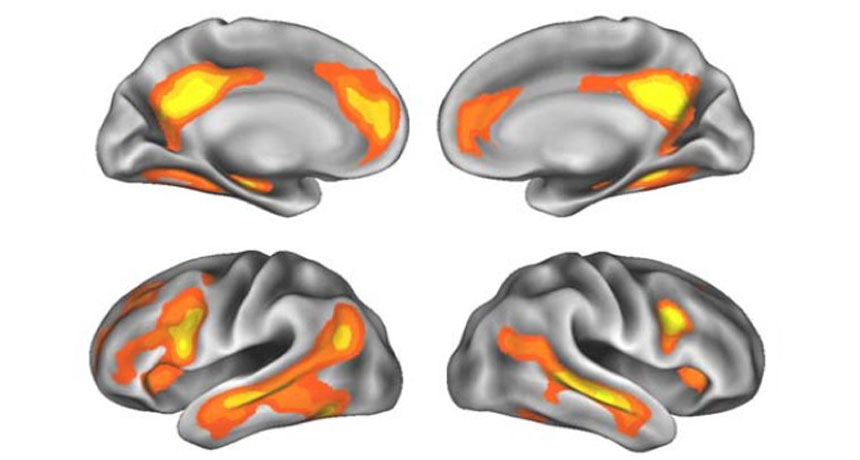
How Does Pregnancy Alter Grey Matter in Brain Study?
How does pregnancy alter grey matter in brain study? It’s a question that’s fascinated scientists for years, and for good reason! Pregnancy is a monumental shift for a woman’s body, impacting everything from hormone levels to sleep patterns. But what’s happening inside the brain? Recent research is uncovering fascinating changes in grey matter – the brain’s thinking tissue – during and after pregnancy.
This isn’t just about brain shrinkage; it’s about complex adaptations that may be crucial for motherhood. We’ll dive into the specifics of these changes, exploring the underlying mechanisms and potential long-term implications for both mothers and their babies.
We’ll look at which brain regions are most affected, how hormones and other factors play a role, and what the consequences might be for cognitive function, memory, and even maternal behavior. Get ready for a fascinating journey into the amazing plasticity of the human brain!
Pregnancy’s Impact on Brain Structure

Source: mdpi-res.com
Pregnancy is a transformative period for a woman’s body, involving profound physiological and hormonal changes. Beyond the obvious physical alterations, pregnancy also affects the brain, a fascinating area of ongoing research. These changes are not simply about managing the demands of gestation and childbirth; they represent a complex interplay of hormonal shifts, neurochemical adjustments, and adaptive responses that prepare the mother for the challenges of motherhood.
Studying these changes, particularly in grey matter, is crucial for understanding maternal brain plasticity and its potential long-term effects on both the mother and child.The significance of studying grey matter changes during pregnancy lies in the grey matter’s role in higher-level cognitive functions, including memory, emotion regulation, and social cognition. Alterations in grey matter volume and density during pregnancy could impact a mother’s ability to navigate the complex demands of caring for a newborn, influencing her emotional well-being and her interactions with her child.
Understanding these changes can also help us identify potential risk factors for postpartum mental health disorders and develop targeted interventions.
Limitations of Current Research on Pregnancy and Grey Matter
Current research on pregnancy-induced grey matter alterations faces several limitations. Firstly, studies often rely on small sample sizes, making it difficult to generalize findings to the broader population. Secondly, the methodologies used vary widely, making it challenging to compare results across different studies. For instance, some studies use structural MRI, while others employ functional MRI or diffusion tensor imaging (DTI), each offering a unique perspective but with inherent limitations in terms of spatial resolution and the specific aspects of brain structure and function they capture.
So, studies show pregnancy significantly alters grey matter in the brain, impacting areas related to social cognition and memory. It’s fascinating to consider this alongside the choices women make about their reproductive timeline, like Karishma Mehta’s decision to freeze her eggs, as detailed in this article: karishma mehta gets her eggs frozen know risks associated with egg freezing.
Understanding these brain changes helps us better appreciate the profound physical and mental transformations of motherhood, even before conception.
Thirdly, the temporal resolution of many studies is limited, meaning the precise timing and trajectory of grey matter changes throughout pregnancy and the postpartum period are not always fully elucidated. Longitudinal studies, tracking changes over time in the same individuals, are crucial to address this limitation but are often challenging to conduct due to the logistical complexities of following pregnant women over extended periods.
Finally, the interplay between various factors, including pre-existing conditions, lifestyle choices, and socio-economic status, needs further investigation to better understand their influence on pregnancy-related brain changes.
Grey Matter Changes
Pregnancy triggers a fascinating cascade of hormonal and physiological changes, and one of the most intriguing is its impact on the brain’s structure. While the overall brain volume remains relatively stable, studies reveal significant alterations in grey matter density and volume in specific regions. Understanding these changes is crucial for comprehending the cognitive and emotional shifts experienced during and after pregnancy.Pregnancy-related grey matter changes aren’t uniform across the entire brain.
Instead, they appear concentrated in particular areas, reflecting the complex interplay between hormonal fluctuations, neuroplasticity, and the demands of motherhood. These alterations aren’t necessarily indicative of damage or decline, but rather a dynamic adaptation reflecting the brain’s remarkable capacity to remodel itself in response to significant life events.
Specific Brain Regions and Grey Matter Alterations
Research using neuroimaging techniques like MRI has pinpointed several brain regions showing grey matter alterations during pregnancy. These changes often involve a reduction in grey matter density in some areas and an increase in others, reflecting both functional adjustments and the process of neural pruning and reorganization. The magnitude of these changes can vary considerably depending on the specific brain region and individual factors such as pre-pregnancy brain structure and lifestyle.
| Brain Region | Change Type (increase/decrease) | Magnitude (approximate percentage change, where available) | Associated Cognitive Function |
|---|---|---|---|
| Prefrontal Cortex | Decrease | Studies show variable reductions, ranging from a few percent to potentially higher depending on the specific sub-region and analysis methods. | Executive function, planning, decision-making, social cognition |
| Parietal Lobe | Decrease | Similar variability as prefrontal cortex; some studies show minimal changes while others report more substantial reductions. | Spatial processing, sensory integration, attention |
| Hippocampus | Decrease | Again, variability exists, but reductions are frequently reported, potentially reflecting a process of synaptic pruning and reorganization. | Memory consolidation, learning, spatial navigation |
| Amygdala | Increase | Increases are often observed, potentially reflecting heightened emotional processing and responsiveness. Precise magnitude is difficult to quantify consistently across studies. | Emotional processing, fear response, social behavior |
| Temporoparietal Junction | Decrease | Reductions are reported, although the exact magnitude is debated across different studies and methodologies. | Theory of mind, empathy, social perception |
Mechanisms Underlying Grey Matter Alterations

Source: co.uk
Pregnancy triggers a fascinating cascade of physiological changes, and the observed alterations in grey matter volume are not simply random occurrences. Instead, they are likely the result of a complex interplay of hormonal shifts, neural plasticity, and the physiological stress of carrying a child. Understanding these underlying mechanisms is crucial to fully appreciating the significance of these brain changes for both the mother and the developing child.The observed grey matter reductions and increases in specific brain regions are not isolated events; rather, they are intricately linked to the hormonal fluctuations experienced throughout pregnancy.
Hormonal Influences on Grey Matter
The dramatic increase in estrogen and progesterone during pregnancy profoundly impacts the brain. These hormones are known to influence neurogenesis, synaptogenesis, and the expression of various genes affecting neuronal structure and function. For example, estrogen has been shown to promote neuroprotective effects in certain brain regions, potentially counteracting the negative impacts of stress. Conversely, excessive progesterone levels might contribute to some of the observed grey matter reductions in areas associated with memory and cognitive function.
Further research is needed to fully elucidate the precise role of each hormone and their interactions in shaping these brain structural changes. The timing of these hormonal shifts is also crucial, with different phases of pregnancy likely having distinct effects on brain structure.
Neural Plasticity and Synaptic Remodeling
Pregnancy is a period of significant neural plasticity, a process that allows the brain to adapt and reorganize itself in response to environmental demands. This plasticity involves synaptic remodeling – the strengthening or weakening of connections between neurons. During pregnancy, the brain undergoes substantial synaptic remodeling to accommodate the cognitive, emotional, and physiological demands of motherhood. This process might involve the creation of new synapses (synaptogenesis) or the elimination of existing ones (synaptic pruning), leading to the observed changes in grey matter density.
The brain regions most involved in social cognition and maternal behavior show the most significant changes, reflecting the adaptive reorganization needed for successful parenting.
So, research shows pregnancy actually shrinks grey matter in certain brain regions, which is fascinating! This makes me wonder about nutritional needs during this period, and how those needs might differ from men’s. Check out this article on how are women and men receptive of different types of food and game changing superfoods for women , because understanding those differences could be key to supporting brain health during and after pregnancy.
The changes in grey matter are temporary, but providing the right nutrients might help mitigate any negative effects.
Sleep Deprivation and Stress During Pregnancy
Pregnancy often comes with significant sleep deprivation and increased stress levels. Both of these factors are known to negatively impact brain structure and function. Sleep deprivation can impair synaptic plasticity, leading to decreased grey matter volume in several regions, including the prefrontal cortex – a crucial area for executive functions. Chronic stress, on the other hand, elevates cortisol levels, a hormone that can have detrimental effects on neuronal health and survival.
The combined impact of sleep deprivation and stress during pregnancy could exacerbate the observed grey matter alterations, potentially contributing to postpartum cognitive difficulties experienced by some women. Studies investigating the independent and combined effects of these factors on brain structure during and after pregnancy are needed to better understand their contribution to these changes.
Cognitive and Behavioral Implications
Pregnancy triggers remarkable changes in a woman’s brain, extending beyond the structural alterations in grey matter we’ve already discussed. These changes are intricately linked to significant shifts in cognitive function and behavior, impacting various aspects of a mother’s life, from her daily experiences to her interactions with her newborn. Understanding these implications is crucial for supporting maternal well-being and optimizing the parent-child bond.The impact of pregnancy on cognition is multifaceted and dynamic, varying across individuals and stages of pregnancy and postpartum.
Studies comparing cognitive performance before, during, and after pregnancy reveal a complex interplay of improvements and declines in specific cognitive domains. While some women experience enhanced performance in certain areas, others may see temporary deficits. These fluctuations aren’t necessarily indicative of pathology but rather reflect the body’s remarkable adaptation to the demands of pregnancy and motherhood.
Memory Changes During and After Pregnancy
Studies suggest that pregnancy can affect various aspects of memory, including verbal memory and spatial memory. For example, some research indicates a decline in verbal fluency and recall during pregnancy, potentially linked to hormonal fluctuations and sleep disturbances. However, other studies have shown improvements in certain types of memory, particularly those related to the baby and motherhood. The post-partum period often presents a unique set of memory challenges, with some women reporting difficulties with short-term memory and concentration.
These changes are likely influenced by a complex interaction of hormonal shifts, sleep deprivation, and the overwhelming demands of caring for a newborn. For instance, a mother might struggle to remember where she put her keys but have an exceptional memory for her baby’s feeding schedule. This illustrates the selective nature of memory changes observed during this period.
Attention and Executive Function
Changes in grey matter volume, particularly in regions associated with attention and executive function, such as the prefrontal cortex, may contribute to alterations in these cognitive domains during and after pregnancy. Some women report increased distractibility and difficulty with multitasking during pregnancy, potentially related to hormonal changes and sleep disruption. These changes are often temporary, resolving after childbirth.
However, in some cases, persistent difficulties with attention and executive function can be observed in the postpartum period, possibly linked to sleep deprivation, stress, and hormonal imbalances. A mother might find it challenging to concentrate on work tasks, while simultaneously managing the needs of her infant. This highlights the practical implications of these cognitive shifts.
Emotional Processing and Maternal Behavior
Pregnancy is associated with significant hormonal shifts, which profoundly impact emotional processing. Alterations in grey matter volume in brain regions involved in emotional regulation, such as the amygdala and hippocampus, might explain observed changes in mood and emotional reactivity. The increased sensitivity to emotional stimuli during pregnancy and postpartum may contribute to heightened anxiety, irritability, and even postpartum depression in some women.
So, research shows pregnancy massively reshapes a woman’s brain, altering grey matter volume in areas linked to social cognition. It’s fascinating to consider how these changes might relate to other neurological conditions; for example, understanding the brain’s plasticity could inform approaches for managing conditions like Tourette Syndrome. For helpful strategies in that area, check out this resource on strategies to manage Tourette syndrome in children.
Ultimately, studying pregnancy’s impact on the brain opens doors to understanding broader neurological processes and potential interventions.
Conversely, these same changes might also enhance empathy and bonding with the infant. For example, a mother’s heightened sensitivity to her baby’s cries could be interpreted as a protective mechanism fostering a strong parent-child bond, illustrating the complex interplay between brain changes and maternal behavior. The heightened emotional sensitivity, while sometimes challenging, often plays a crucial role in the development of maternal caregiving.
Long-Term Effects and Recovery
The changes in grey matter volume observed during pregnancy don’t simply vanish after childbirth. Many studies suggest that some alterations persist, albeit often to a lesser degree, raising important questions about the long-term consequences for maternal brain structure and function. Understanding the extent of these persistent changes and the factors influencing recovery is crucial for a complete picture of pregnancy’s impact on the female brain.The postpartum period is a dynamic phase characterized by significant hormonal fluctuations and lifestyle adjustments.
These factors, along with the ongoing demands of caring for a newborn, likely play a significant role in the recovery process. While some grey matter regions may return to pre-pregnancy volumes, others may show lingering differences, potentially influencing cognitive abilities and emotional regulation in the long term. The speed and completeness of recovery appear to vary considerably between individuals, highlighting the complexity of this process and the need for further research to identify predictive factors.
Persistence of Grey Matter Changes Postpartum, How does pregnancy alter grey matter in brain study
Research indicates that some grey matter volume reductions observed during pregnancy may not fully reverse postpartum. Studies using MRI scans have shown that certain brain regions, particularly those associated with social cognition and emotional processing, may exhibit persistently reduced grey matter volume months or even years after delivery. The extent of this persistence is likely influenced by various factors, including individual genetic predispositions, pre-pregnancy brain structure, and the overall postpartum experience.
For instance, mothers experiencing significant postpartum stress or sleep deprivation might exhibit a slower recovery rate compared to those with more supportive environments and better coping mechanisms. These findings underscore the need for longitudinal studies tracking brain changes throughout the entire postpartum period and beyond.
Factors Influencing Grey Matter Volume Recovery
Several factors are believed to influence the rate and extent of grey matter volume recovery after childbirth. These include hormonal changes, sleep quality, stress levels, social support, and lifestyle factors. The dramatic hormonal shifts that occur following delivery, particularly the decrease in estrogen and progesterone, are thought to play a crucial role in brain plasticity and the restoration of grey matter volume.
Similarly, chronic sleep deprivation, often experienced by new mothers, is associated with impaired cognitive function and may negatively impact brain recovery. High levels of stress, coupled with limited social support, can further hinder the recovery process. Conversely, mothers who receive adequate social support and engage in healthy lifestyle practices, including regular exercise and a balanced diet, may experience faster and more complete recovery.
Potential Long-Term Implications for Maternal Cognitive Function
The persistence of grey matter changes postpartum could have potential long-term implications for maternal cognitive function. While these changes are not necessarily indicative of impairment, they could subtly affect various cognitive domains.
- Memory: Some studies suggest that postpartum women may experience persistent changes in verbal memory and other aspects of memory function.
- Attention: Difficulties with sustained attention and concentration have been reported in some postpartum women, potentially linked to persistent grey matter alterations.
- Executive Function: Executive functions, such as planning, problem-solving, and cognitive flexibility, might be subtly impacted by long-term grey matter changes.
- Emotional Processing: Alterations in brain regions associated with emotional regulation could contribute to increased emotional vulnerability or susceptibility to mood disorders in the postpartum period and beyond.
It’s important to note that these are potential implications and the extent of any cognitive impact varies significantly among individuals. Further research is needed to fully elucidate the relationship between persistent grey matter changes and long-term cognitive outcomes.
Methodological Considerations
Studying the fascinating changes in brain structure during pregnancy requires sophisticated neuroimaging techniques and carefully designed research protocols. The choice of method significantly impacts the quality and interpretability of the results, influencing our understanding of this complex process. Choosing the right tools is crucial for accurately capturing the subtle shifts in grey matter volume and connectivity.
Neuroimaging techniques offer a window into the living brain, allowing researchers to visualize and quantify structural and functional changes. However, each method has its own strengths and limitations, and understanding these is critical for interpreting the findings from pregnancy-related brain studies.
Comparison of Neuroimaging Techniques
Magnetic Resonance Imaging (MRI) and functional Magnetic Resonance Imaging (fMRI) are the workhorses of brain imaging research, each providing unique insights into pregnancy-related brain changes. MRI excels at providing high-resolution anatomical images, allowing researchers to precisely measure grey matter volume and identify structural abnormalities. fMRI, on the other hand, measures brain activity by detecting changes in blood flow, offering insights into functional connectivity and brain networks.
MRI’s strength lies in its ability to provide detailed anatomical information, crucial for assessing changes in grey matter volume and cortical thickness. However, MRI is static; it provides a snapshot of brain structure at a single point in time. It does not directly measure brain activity. fMRI, while providing information about brain activity, has lower spatial resolution than MRI and can be susceptible to motion artifacts, which can be a significant challenge when scanning pregnant participants.
Strengths and Limitations of MRI and fMRI
| Technique | Strengths | Limitations |
|---|---|---|
| MRI | High spatial resolution, excellent for visualizing anatomical structures, quantifies grey matter volume and cortical thickness. | Static image, doesn’t directly measure brain activity, susceptible to artifacts from metal implants or movement. |
| fMRI | Measures brain activity, assesses functional connectivity, can identify regions involved in cognitive processes. | Lower spatial resolution than MRI, susceptible to motion artifacts (especially relevant in pregnancy), interpretation can be complex. |
Study Designs in Pregnancy Brain Research
The choice of study design is critical in understanding the dynamic changes occurring in the brain during pregnancy. Longitudinal studies and cross-sectional studies offer different perspectives on this process.
Longitudinal studies follow the same participants over time, allowing researchers to track brain changes across different stages of pregnancy and the postpartum period. This approach provides invaluable insights into the temporal dynamics of brain alterations. However, longitudinal studies are resource-intensive and time-consuming, and participant attrition can be a significant challenge.
Cross-sectional studies compare different groups of women at various stages of pregnancy or postpartum. While less expensive and time-consuming than longitudinal studies, cross-sectional designs cannot directly track individual changes over time. They can only provide a snapshot of brain structure and function at specific points in pregnancy.
Future Research Directions: How Does Pregnancy Alter Grey Matter In Brain Study
The study of pregnancy’s impact on the brain is a burgeoning field, yielding fascinating insights but also leaving many crucial questions unanswered. Further research is vital not only to deepen our understanding of these changes but also to inform clinical practice and improve the well-being of mothers and their infants. This requires a multidisciplinary approach, combining neuroimaging techniques, hormonal assays, and rigorous cognitive assessments.The long-term consequences of pregnancy-induced brain alterations remain largely unexplored.
While some changes may be transient, others could have lasting effects on cognitive function and mental health. A more comprehensive understanding of these long-term impacts is crucial for developing targeted interventions and support systems for postpartum women.
Longitudinal Studies and Individual Variability
Longitudinal studies tracking brain structure and cognitive function across multiple time points, from pregnancy through postpartum and beyond, are needed to fully characterize the trajectory of these changes. This will allow researchers to identify individuals at higher risk for persistent cognitive or emotional difficulties and to investigate potential mediating factors such as genetic predisposition, socioeconomic status, and pre-existing mental health conditions.
For example, a study could follow a cohort of women from the first trimester of pregnancy through five years postpartum, using MRI scans to assess grey matter volume changes and cognitive tests to evaluate memory, attention, and executive function at each time point. This would allow researchers to identify patterns of change and determine which women experience more significant or persistent alterations.
Mechanisms of Hormonal Influence on Neural Plasticity
A deeper understanding of the intricate interplay between hormonal fluctuations, neural plasticity, and cognitive function is essential. Research should focus on identifying specific hormones and neurotransmitters that mediate these changes and exploring how these mechanisms interact with individual genetic predispositions. For instance, studies could investigate the role of estrogen, progesterone, and oxytocin in modulating synaptic plasticity, neurogenesis, and myelination within specific brain regions.
This could involve examining the expression levels of relevant genes and proteins in brain tissue samples or using animal models to study the effects of hormonal manipulations on brain structure and function.
Visual Representation of Interplay
Imagine a three-dimensional model. At the center is a dynamic representation of the brain, with different regions highlighted to show varying degrees of grey matter volume changes throughout pregnancy and postpartum. Arrows emanating from the brain connect to three spheres representing: 1) Hormonal Changes (labeled with key hormones like estrogen, progesterone, and cortisol, with fluctuating levels indicated by the size or color intensity of the spheres); 2) Neural Plasticity (showing processes like synaptogenesis, pruning, and myelination, visualized as animated changes in the brain model); and 3) Cognitive Function (represented by icons symbolizing memory, attention, and executive function, with their intensity reflecting performance levels).
The connections between the spheres illustrate the dynamic interplay. For example, a surge in estrogen during pregnancy could be shown by an increase in the size of the “Hormonal Changes” sphere, which in turn influences the “Neural Plasticity” sphere, leading to increased synaptogenesis in specific brain regions (visualized as growth in the brain model), and ultimately affecting cognitive function (represented by an increase in the size or brightness of relevant cognitive function icons).
Postpartum hormonal shifts would be shown as changes in the size and color of the “Hormonal Changes” sphere, impacting “Neural Plasticity” and subsequently “Cognitive Function” accordingly. This model visually demonstrates the complex, bidirectional relationships between hormonal fluctuations, neural plasticity, and cognitive function throughout the perinatal period.
Last Word

Source: sciencenews.org
So, pregnancy isn’t just about growing a baby; it’s a transformative experience that profoundly reshapes the maternal brain. The changes in grey matter, while initially perplexing, are likely adaptive mechanisms designed to enhance a mother’s ability to care for her newborn. While much remains to be discovered, ongoing research promises to further illuminate the intricate interplay between hormonal shifts, neural plasticity, and the remarkable cognitive and behavioral adaptations that occur during and after pregnancy.
It’s a testament to the incredible adaptability of the human brain and the profound power of motherhood.
Query Resolution
Is it harmful to experience grey matter changes during pregnancy?
Not necessarily. These changes are likely adaptive and related to the demands of motherhood. However, more research is needed to fully understand the long-term effects.
Do these grey matter changes affect IQ or intelligence?
Current research doesn’t suggest a direct impact on overall IQ. The changes appear to be more focused on specific cognitive functions, like memory and emotional processing.
How long do these brain changes last after pregnancy?
The duration varies, with some changes persisting for months or even years postpartum. Recovery is influenced by various factors, including sleep, stress levels, and overall health.
Can these brain changes be reversed?
Many of the changes appear to be reversible, but the timeline and extent of recovery are still under investigation.
